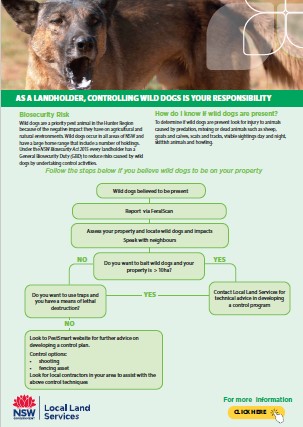
Wild dogs
Anyone who has experienced wild dog attacks on their livestock will confirm it's a stressful and traumatic experience.
The impacts on both livestock and landholder can be significant so we strongly encourage you to plan for wild dogs if you maintain livestock on your land.
About wild dogs
 Wild dogs refer to all wild-living dogs including dingoes, feral domestic dogs and the hybrid descendants of these.
Wild dogs refer to all wild-living dogs including dingoes, feral domestic dogs and the hybrid descendants of these.
They are extremely cunning, which can make their control difficult.
Wild dogs generally operate individually or in a small group, but rarely as a pack. They prey on livestock and native fauna, and spread diseases that affect livestock, pets, native animals and humans. They also pose a direct threat to domesticated pets and animals, as well as humans.
It is vital that you report all sightings and stock losses. Sightings and wild dog attacks should be reported to your Local Land Services office.
To better understand your wild dog control options, download the decision tool. PDF, 259.76 KB
Biosecurity Risk
Wild dogs occur in all areas of NSW and have a large home range that include a number of holdings. Under the NSW Biosecurity Act 2015 every landholder has a General Biosecurity Duty to reduce risks caused by wild dogs by undertaking control activities.
How do I know if wild dogs are present?
To determine if wild dogs are present look for:
- injury to animals caused by predation
- missing or dead animals such as sheep, goats and calves
- scats and tracks
- visible sightings day and night
- skittish animals
- howling.
Find out more about wild dog control
- Responsible wild dog control [422.6 KB PDF]
- Wild dog control decision tool [259.8 KB PDF]
- Understanding your regional pest plan
- Wild dogs - how to recognise the signs
- Professional Wild Dog Controller Program (Hunter region)
- Wild dog biology and distribution ( NSW DPI)
- Wild dogs - the issue, planning and management (PestSmart)
- Glovebox guide for managing wild dogs (PestSmart)
- Report wild dog activity (WildDogScan)